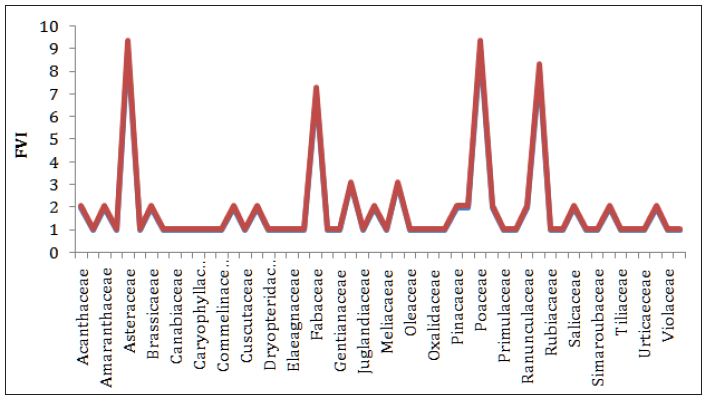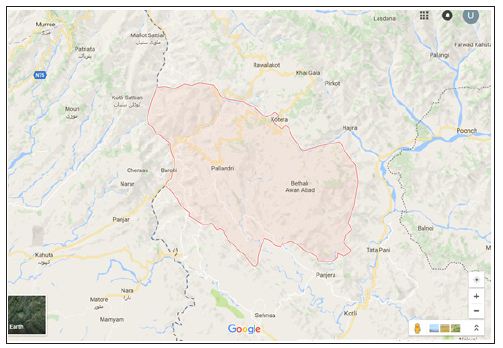Impact Factor : 0.548
- NLM ID: 101723284
- OCoLC: 999826537
- LCCN: 2017202541
Anam Shabir*, Naveed Iqbal Raja, Uneeza Javaid, Noor Ul Ain Zafar, Hina Javed and Farhat Yasmeen
Received: September 22, 2017; Published: November 07, 2017
Corresponding author: Anam Shabir, Department of Botany, Faculty of Sciences PirMehr Ali Shah Arid Agriculture University Rawalpindi Pakistan
DOI: 10.26717/BJSTR.2017.01.000501
Plants play vital role in our existence and are major substance of nutrition and medicament throughout the world. Plants are being used from early times to treat various human as well as animal’s diseases. A series of survey were conducted to notice the highly remedial plants of Devi Galli Sudhnoti, Azad Jammu and Kashmir, Pakistan. Data was collected by direct comments during field studies, interviews and questionnaires from the local people. The locality, botanical, vernacular names, their family names and uses were elected. During study a total of 98 plants species related to 88 genera and 51 families were recorded. Most abundantly recorded families were Asteraceae, Poaceae, Moraceae, Convolvolaceae, Rosaceae, Fabaceae and Lamiaceae. Ethnobotanical uses classifications showed that major proportion was of medicinal plants species (85 spp, 90.4%) then fodder and forage species were (43 spp, 45.7%) It is followed by other uses such as vegetables (13 spp, 13.8%), fruit (19 spp, 20.2%), Fuel (16 spp, 17%) and timber species (5 spp, 5.3%). Present survey has disclosed the ethno botanical importance of the plants and also suggested that there is dire need of conservation of these medicinally important plants for sustainable utilization as they are threatened by the loss of habitat and over exploitation.
Keywords: Devi Galli; Inhabitants; Flora; Ethnobotany
Abbreviations: FC: Frequency Citation; RFC: Relative Frequency Citation; UV: Use Value; FIV: Family importance value.
Ethnobotany deals with study of the relationship between people of a specific culture and native plants and plays a significant role in understanding the active relations between social, traditional systems and biological diversity Husain et al. [1]; Mahmood et al.[2]. From many centuries and even today medicinal plants are used for dealing and prevention of various disorders and for the advancement of good health for people Alpuerto et al.[3]; Khatun et al. [4]. In Pakistan medicinal plants have been used as remedies for human diseases as well as for animal diseases for many centuries Haq [5]. Freshly collected ingredients from plants in small and massive quantities are used for ailments and also provided to the herbal industries through traded in the market place Uniyal et al. [6]. Hilly regions offer properties and services such as forests, agriculture foodstuffs, and water and biodiversity resources not only useable for local hilly area’s people but also to a large part of the population living in plain areas Awan and Ahmad [7].
Azad Jammu and Kashmir (AJ&K) is full of medicinal plants diversity. Many studies have been conducted on the uses of therapeutic plants by the indigenous populations of Azad Jammu and Kashmir Ishtiaq et al. [8]. District Sudhnoti is adjacent to Poonch division and situated at the height of 5400 ft. Most of areas of district Sudhnoti are out of the snow zone but some are in snow zone Khan et al. [9]. The flora of this district is also different from other districts. Vegetation of this district is patchy and dense with high alpine trees, whereas shrubs and small bushes are in large number. The World Health Organization (WHO) estimated that 80% of the population of developing countries relies on traditional medicines, mostly plant drugs, for their primary healthcare needs (WHO, 2017). Demand for medicinal plant is increasing in both developing and developed countries due to growing recognition of natural products, being non-narcotic, having no side-effects, easily available at affordable prices and sometime the only source of health care available to the poor Basha. The area is selected due to pronounced variety of medicinal plants but the region is still unexplored. The main objective was to document the knowledge of the local people of Devi Galli about the medicinal uses of local plants.
a) Study Area: The study area, District Sudhnoti is part of Division Poonch. Ethnobotanical study was limited to Devi Galli district (Sudhnoti) and some allied areas of district SudhnotiAzad Kashmir. District Sudhnoti is spread over 569 sq. km and Devi Galli is a part of Sudhnoti Rafi et al. [10].
b) Field Trips: Field survey was consisting of plant collection, photography and data records. Semi-structured and open-ended interviews (questionnaire) were planned to gather ethnobotanical data. Interviews were taken general from native people of different age groups, shepherds and herbalists (Hakims) in their local language.
c) Plants Collection and Preservation: During various field surveys medicinally important plants were collected by keeping in view their utilization, flowering period and their products. These fully dehydrated samples were mounted on herbarium sheets and then noted their local name, botanical name, family, flower colour and locality. The plant species were recognized by plant taxonomists of UAAR and also used the Flora of Pakistan.
d) Quantitative Ethnobotanical Data Analysis: Indigenous knowledge was quantitatively calculated using various methods like Relative Frequency Citation (RFC), Use Value (UV) and Family Importance Value (FIV).
e) Relative Frequency Citation (RFC): Quantitative analysis of the collected ethno medicinal information was done by using a catalog of relative frequency citation (RFC) as; RFC= FC/N (0 < RFC < 1) This formula is given by the frequency of citation; FC that is the number of informants who mention the use of the species) while N is the total number of informants participating in the survey Vitalini et al.[11].
f) Use Value (UV): The Use Value (UV) is a good measure to all the possible uses of a plant species. UV gives us the virtual significance of a species that are cited by an informant for a specific species of medicinal plant. It will be intended by using the following given formula Savikin et al. [12].
Equation 1:

Where Ui is the number of uses revealed by each informer for a given species and N is the total number of informants.
g) Family importance value (FIV): Family importance value (FIV) was calculated by captivating the percentage of informants who mention the family Savikin.
Equation 2:

Where (FC) is the number of informants who mention the family while (N) is the total number of informants contributing in the study.
During Ethnobotanical study, a total of 98 plant species related to 88 genera and 51 different families are documented. Most of these species are used by native individuals for a multiplicity of purposes. (Table 1) contains botanical, local names, family name and folkloric uses, (Table 2) represent FC, RFC and UV of different plants. A total of 135 participants were interviewed out of which 46 were male and 89 were females of different age group. Majority ofpeople were uneducated 97 were married and 31 unmarried only 6 were herbalist and 129 were local people.
Table 1: List of plants species with uses.

Table 2: Use Value, Frequency Citation and Relative Frequency Citation of plants.

Most abundantly recorded families were Asteraceae, Poaceae, Moraceae, Convolvolaceae, Rosaceae, Fabaceae and Lamiaceae. Ethnobotanical uses classifications showed that major proportion of medicinal plants species was (85 spp, 90.4%) then fodder and forage species were (43 spp, 45.7%) It is followed by other uses such as vegetables (13 spp, 13.8%), fruit (19 spp, 20.2%), Fuel (16 spp, 17%) and timber species (5 spp, 5.3%).
Relative frequency citation was considered to record maximum therapeutic flora of the area which is utilized for treatment of various ailments. It gives the number of informers who mention the uses of plants. Most cited plants were Mentha arvensis L. (0.74), Chichorium intybus L. (0.66), Anagallis arvensis L (0.54), Oxalis corniculata (L.) (0.59), Melia azedrach L (0.54), Digtaria senguinalis L. Scop (0.44), Viola odorata Linn. (0.64).
The use value (UV) is technique for measurable analysis of data it gives the important uses of species. Some of plants were recorded with high UV that are Anagallis arvensis L. (0.92), Mentha longifolia L. (0.82), Mentha arvensis L. (0.82), Prunus bokharensis (Royle) (0.71), Morus nigra L. (0.67), Sorghum halepense Pers. (0.65), Melia azedrach L. (0.6), Viola odorata Linn. (0.59), Zanthoxylum armatum DC. (0.51),Punica granatum L. (0.50), Pyrus pashia Buch. (0.34), Taraxicum officinale (Weber) (0.26), Rubus elipticus Smith. (0.22) etc.
Family importance value is calculated and described in the form of graph in Figures 1,2. Amaranthaceae, Asteraceae, Poaceae, Moraceae, Convolvolaceae, Rosaceae, Fabaceae and Lamiaceae were most abundantly reported families.
Figure 1: Families.

Figure 2:

In present survey, the ethno botanical importance of the plants inhabiting Devi Galli is explored. Almost all the plant species were found important in one way or the other. Ajaib et al. [13 ] mentioned the medicinal importance of Berrberis lycium Royle, Jasminum humile L and Rubus elipticus Smith which were recorded in district Kotli, Azad Jammu and Kashmir. Ahmad et al. [13] also reported ethnobotanical uses of plants reported from district kotli including Achyranthus aspera and Adiantum venustum D. Don. Importance of these plants is also confirmed by Qureshi, Mehmood, Khan, Ishtiaq, Amjad. The need of the hour is to document and preserve the traditional knowledge about the medicinal uses of different plants as the new people are giving more importance to allelopathic medicines and the traditional knowledge is only confined to old people.
The current investigation discloses that indigenous knowledge is limited to native values, so this valuable treasure will be surely lost by any change in traditional culture. Ethno botanically important plants which are valuable global resources are threatened by the loss of habitats and over exploitation. The principle reason of over exploitation is lack of knowledge about the importance of plants and suitable harvest time and practice. The Devi Galli (Sodhnuti) contains diverse vegetation due to variation in climatic conditions and altitude. The people of the area to a large extent fulfill their common requirements such as food, medicine, fodder or forageand timber from plants. People of the area are not much aware about the medicinal treasure present in there this is because of illiteracy. Ethno botanically important area should be replenished by reforestation, establishment of home botanical gardens, conservation of natural resources, minimizing over grazing and harvesting for various purposes.


